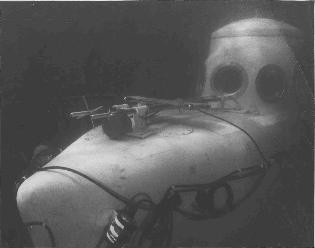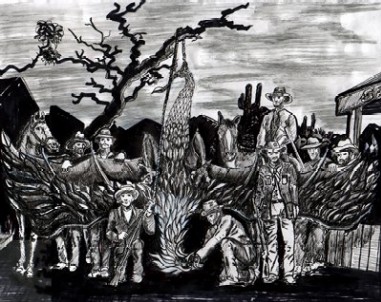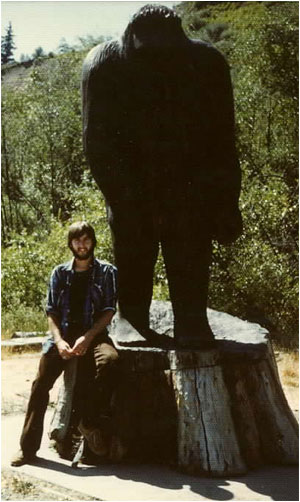
December 1, 2006

There is nothing wrong with your computer. Do not attempt to adjust your screen. We are controlling transmission. We can reduce the focus to a soft blur, or sharpen it to crystal clarity (actually, we can’t and the cartoon above is out of focus, on purpose). For the next few minutes, sit quietly and we will control all that you read. You are about to experience the awe and mystery which reaches from the inner mind to… Cryptomundo.
Well, sometimes it might seem that way, but this blog is an example of how people can read words, names, monikers, and terms, and walk away with a totally different sense of reality from that which we might be trying to share. That’s okay. Perhaps this creates possibilities in all our tomorrows for more comprehensive discourses.
Scott Maruna, the managing editor of The Anomalist newsline, has written a blog today, entitled "The Cryptosemantics of Cryptozoology" .
Scott begins by saying:
One hang-up and contention I have with the study of cryptozoology: semantics. I will present my case here and honestly hope that someone out there can guide, help or even correct me if I am wrong. However, so long as I have been involved in this field, the semantics of it has always seemd to be a glaring weak spot, one that needs cleaned up.
Read his blog for the scenarios and situations he gives – on Bigfoot, Chupacabras, Nessie, and Thunderbirds. Maruna asks questions that haunt the line between the undiscovered and the discovery, for example:
“Is that a Bigfoot or not?”
"Chupacabra[s]…What is it? How is it that we will know when one is found?"
"A biologist discovers an eel species within the loch that, in certain situations and conditions, grows to colossal proportions. Would this be announced as the long-awaited discovery of the enigmatic Loch Ness Monster?"
"My research has shown that that gigantic Washington eagle did exist and quite possibly still does exist. Does that make it a Thunderbird?"
My response is below:
^^^^^^^^^^^^^^
I have usually found the major source of misunderstanding the words and terms linked to cryptozoology is by internalizing the more popular or media-driven sense of what the field is all about. For those that wish to take some time to reach a little deeper, as Scott is demonstrating here, there are clearer answers.
Cryptids, as I have written about often, are unknown until they are identified. Look, if a cryptid is positively found to be a mistake, a hoax, a known species, it will be said to be that. If it is an unknown species, newly confirmed and discovered, it will be congratulated, probably, as a success story of cryptozoology. But, of course, once that species is assuredly identified as "new," it will also join the ranks of zoology and/or anthropology. The same goes for a "re-discovered" species, such as the Laotian rock rat or the Ivory-billed woodpecker.
I highly recommend people interested read the fuller definitions click on my blog on cryptoterms, here:

Therefore, allow me to attempt to very directly answer the above blog’s diverse and dissimilar scenarios. Here’s how a middle-of-the-road cryptozoologist, like me, might see this unfolding:
If Bigfoot is a new species or an extinct species confirmed alive, it’s Latin name and popular name will be retained or newly created to reflect it being a bigfoot or sasquatch or something similar. But if Bigfoot is confirmed, for example, as a tribe of hairy Indians (Homo sapiens), they will no longer be called "Bigfoot," no doubt. They would be seen as merely a very strange (with no value judgments) variety of humans, but still Homo sapiens sapiens.

Now Chupacabras is another, radically different situation. Chupacabras (yes, it is a Spanish word that is spelled like an English plural, but that form is both singular and plural) has become an umbrella term. The Latin cryptid name is much like the regional name "Jersey Devil" and they both attempt to cover all kinds of weird and unfamiliar animal and creature reports based on a location focus, not a zoological focus.
Reporters in the American Southwest incorrectly use Chupacabras all the time to talk about canid (all kinds of doglike animals with mange and health problems) photos that come into their newsrooms. These "Chupacabras" have little to do with the cryptid Chupacabras from Puerto Rico, first reported extensively in the 1970s, which are bipedal, hairy, with spiked hair, that killed goats. The SW’s misnamed Chupacabras are frequently identified as "diseased foxes," "sick dogs," or "mangy coyotes" because that is what they are. But they have nothing to do with the initial Chupacabras, therefore the Chupacabras continue to remain part of cryptozoology.

Now on to the Nessie situation. Scott writes a "wholly hypothetical situation: a biologist discovers an eel species within the loch that, in certain situations and conditions, grows to colossal proportions. Would this be announced as the long-awaited discovery of the enigmatic Loch Ness Monster? I doubt it."
But I think it would.
The key here may be whether or not this is a "wholly" new eel species, or a "wholly" unknown subspecies just occurring in Loch Ness. Yes, of course, it would be the Loch Ness Monster if this discovery occurred, and was found as the source of the reports. (But cryptozoologists might have questions about how a giant eel produced sightings of LNMs with eyelashes, hair on their bodies, and a mane. Or were these eels responsible for the sightings of the large walrus-like animals seen crossing the roads?)
Hardly anyone that is a Loch Ness investigator considers the plesiosaur-in-a-cage scenario one that is going to happen, especially since the most common sightings have an overturned boat appearance, with mammalian characteristics.
But yes, if it was a *new* species of giant eel, then, of course, this would have to be labeled the Loch Ness Monster. Then the zoologists would rush in, pushing aside the cryptozoologists.

The Thunderbird question seems simple enough. If it is proven, beyond a shadow of doubt, that nothing exists, end of the story. If the Thunderbird sightings are definitely linked to a new, unknown, or formerly extinct species, that’s your Thunderbird. If you try to explain Thunderbird sightings by saying they are, for example, turkey vultures, cranes, and ravens, the mystery of this cryptid continues, as those choices do not explain all the reports and the mystery remains.
An open-minded cryptozoologist would not care if the Thunderbird turns out to be a teratorn or a Washington eagle, if they were caught. But cryptozoologists will keep the Thunderbird file active until then, despite debunkers, or despite people who think they are looking for some kind of "formula Thunderbird."
Those that continue to rema
in confused about cryptozoology and its terms by ignoring the realities and recent history of successes (hey, look up the last decade of cryptid names linked to new animals found in SE Asia and Indonesia) are merely setting up strawmen to knock over. That’s of no concern to cryptozoologists who go forward gathering reports of lesser cryptids that turn into new animals or folklore of little people that are linked to new fossil finds from Flores.
I have never experienced cryptosemantics being a barrier in the field. Sometimes I do discover a few cryptoreaders, who are closer to the truth than even they may know, getting frustrated by trying so hard to understand the multi-levels in the differences between the collecting, the labeling, the finding, and the future.

About Loren Coleman
Loren Coleman is one of the world’s leading cryptozoologists, some say “the” leading living cryptozoologist. Certainly, he is acknowledged as the current living American researcher and writer who has most popularized cryptozoology in the late 20th and early 21st centuries.
Starting his fieldwork and investigations in 1960, after traveling and trekking extensively in pursuit of cryptozoological mysteries, Coleman began writing to share his experiences in 1969. An honorary member of Ivan T. Sanderson’s Society for the Investigation of the Unexplained in the 1970s, Coleman has been bestowed with similar honorary memberships of the North Idaho College Cryptozoology Club in 1983, and in subsequent years, that of the British Columbia Scientific Cryptozoology Club, CryptoSafari International, and other international organizations. He was also a Life Member and Benefactor of the International Society of Cryptozoology (now-defunct).
Loren Coleman’s daily blog, as a member of the Cryptomundo Team, served as an ongoing avenue of communication for the ever-growing body of cryptozoo news from 2005 through 2013. He returned as an infrequent contributor beginning Halloween week of 2015.
Coleman is the founder in 2003, and current director of the International Cryptozoology Museum in Portland, Maine.
Filed under Bigfoot, Breaking News, Chupacabras, Comics, Cryptomundo Exclusive, Cryptotourism, CryptoZoo News, Cryptozoologists, Cryptozoology, Extinct, Homo floresiensis, Ivory-Billed Woodpecker